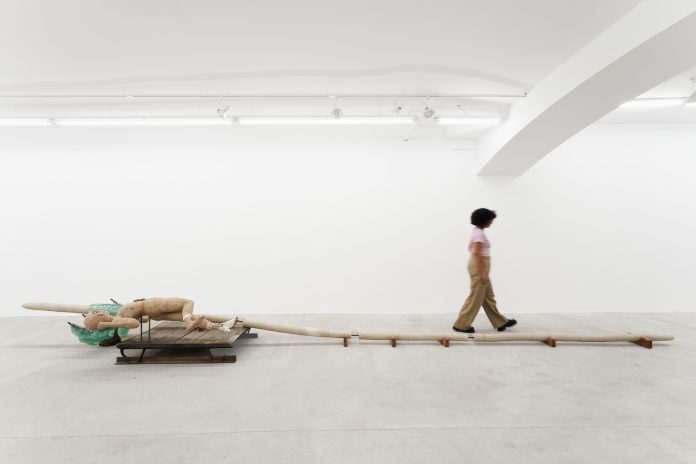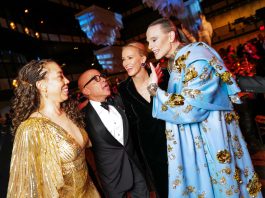Amid the recent wave of gallery closures that has forced the art world to question its business models and structures, Lyles & King, one of New York’s most steadfast champions of emerging talent, is celebrating its 10th anniversary. Founded by Isaac Lyles and Alexandra King-Lyles in 2015, the gallery soon established itself as one to watch in New York’s contemporary art ecosystem. It rose rapidly from modest beginnings in a 1,500-square-foot former restaurant cellar on the Lower East Side, and in September 2020, in the midst of the pandemic, the gallery relocated from its original space at 106 Forsyth Street to a larger gallery at 21 Catherine Street in Chinatown. The new location introduced a more spacious main exhibition area, viewing rooms and a rare outdoor courtyard for sculpture and performance, enabling the gallery to take on more ambitious, institution-level projects. Since then, it has become a cornerstone of the Chinatown art community, recognized for its fearless exhibitions, dynamic roster and commitment to collaboration and inclusivity.
To mark its first major milestone, Lyles & King is presenting an expansive exhibition showcasing works by the community of artists the gallery has helped to nurture and propel into successful careers, and the debut of the show offered Isaac Lyles a moment to pause and reflect on the gallery’s journey so far. Speaking with Observer in the gallery’s outdoor courtyard the day before the opening—a quiet oasis tucked between Chinatown’s buildings and anchored by a 16-foot steel sculpture by Catalina Ouyang—he’s calm, grounded and, above all, grateful.


Despite a sluggish market and the challenges of the past year, he feels renewed. “There’s this new sense of energy and vitality that’s hard to describe, which I think comes from a period of deep reflection, especially through this exhibition,” he says, noting that it’s the gallery’s 113th. “It’s been almost like therapy—an opportunity to look back on what we’ve built as a gallery, the friendships we’ve formed, the choices I might have made differently and the ways I’ve grown both as a person and as a gallerist.”
For Lyles, the most meaningful realization has been twofold: first, that his instincts have almost always been right (when he went against them, it led to mistakes); and second, that learning to trust in time has been essential. “When I started the gallery, I was impatient—always focused on hitting the next milestone,” he reflects. “I’ve come to understand that we were really planting seeds, approaching everything with passion and intelligence and allowing things to grow at their own pace. You can’t rush that process.” Developing that confidence—knowing he’s making choices from the right place and trusting them without being swayed by peers or outside noise—has given him a deeper sense of stability and purpose. Looking back on these ten years, he says, feels like a gift: a reminder of the joy and meaning in what he gets to do every day.
“I feel such joy and privilege; being able to work with the artists I’ve collaborated with over the years is truly astonishing,” he says. Today, Lyles & King’s program reaches beyond the traditional exhibition format, embracing performance, collaboration and experimentation. Just last week, the gallery hosted a performance by Puppies Puppies and Lexi Brown for the closing of Ren Light Pan’s solo show, organized by Cato Young. Next week it will debut another major series of performances. “It’s been an incredible reminder of how alive and collaborative this space can be.”


Lyles’s background is in performance art and, before founding his own gallery, he served as director for Derek Eller and Jack Tilton. Those roles revealed not only his passion but also a natural talent for facilitating others. “I found that profoundly meaningful,” he says, recalling how he had once considered a more academic route, perhaps pursuing a PhD or following an institutional career. What ultimately drew him to the gallery world was its immediacy—the chance to encounter an artwork or idea that moved him and help bring it to life. “You can have a direct impact on an artist’s life, in real time. One of my proudest early memories was making enough sales for an artist to quit their day job. That moment of working together, realizing that their life—and their ability to make the work they wanted—had changed, was unforgettable.”
Lyles has helped launch the careers of several artists who are now firmly established in both the market and institutional spheres. Among them are Kiyan Williams, one of the standout artists of the last Whitney Biennial; collectors’ favorites Lily Wong, Xie Lie and Jessie Makinson; and formerly under-recognized figures the gallery helped bring to international prominence, such as Mira Schor and Polish photographer Aneta Grzeszykowska. Works by artists from the Lyles & King roster are now held in major collections including the Centre Pompidou in Paris; the Guggenheim, MoMA and the Whitney in New York; the Museum of Modern Art in Warsaw; the San Francisco Museum of Modern Art; and the Hammer Museum in Los Angeles.


When asked what the X factor is that he looks for in artists, Lyles says it always begins with an emotional response to the work. “The truth is in the experience of the work—the emotion it evokes, that often indefinable, expansive feeling you can’t quite shake,” he says, explaining that sometimes this response is so immediate it compels him to offer a show on the spot. At other times, it lingers quietly for weeks or even years before evolving into a conversation about an exhibition or collaboration.
Ultimately, his decisions come from that same space of truth and ineffability—where he may not yet have the language to describe the intensity of what he’s feeling but knows he wants to follow it. “That instinct, that curiosity, is what drives me,” he reflects. “It’s the joy of collaborating with an artist and watching an exhibition come to life, of introducing their work to a new audience.”
Lyles & King’s program has never been confined by boundaries, moving fluidly across media, narratives and aesthetics. Lyles cites the English poet John Donne writing “Pleasure is none if not varied”—a sentiment with which he wholeheartedly agrees. “That sense of dynamism is essential for me,” he explains. “I always want room for surprise and for something that challenges expectations. I don’t want to repeat myself or chase a single aesthetic.”
The gallery’s often ambitious exhibitions have featured artists who explore gender, identity and the body. “There are definitely through lines—questions of identity, narrative, technology and how these shape our experience of contemporary life.” He points to Aneta Grzeszykowska, whose work explores identity, photography, memory and family, as quite distinct from artists like Ike Ude or Mira Schor, who engage feminism and materiality from entirely different perspectives. Rosa Loy’s practice, he notes, looks nothing like Schor’s, yet the two share a similar emotional intelligence and psychological depth. He also mentions Jessie Makinson, whose imaginative world-building and narrative sensibility resonate with artists such as Hortensia Mi Kafchin, whose first U.S. solo exhibition the gallery presented. “The forms may differ, but certain emotional or philosophical sympathies run through the work,” he notes. “You can sense it when placing a piece by someone like Chris Dorland beside an older drawing by Mimi Smith or a blueprint by Claes Oldenburg—it’s less about similarity than conversation.”


The gallery’s program reflects Lyles’s ongoing curiosity about how artists translate experience—how technology, history and imagination shape what it means to see and feel in the present. “Those concerns keep resurfacing, though never in quite the same way.” Looking back, he takes pride in having built a family-run business rooted in that neighborhood. “We opened here in September, though I signed the lease in March of 2020—right as everything was shutting down,” he recalls. “My wife gave birth to our first daughter that same month and then the pandemic hit. It was completely surreal. But the decision to be here turned out to be the right one.”
The Chinatown space has allowed Lyles & King to present two exhibitions simultaneously, fostering dialogue between them and creating a dynamic rhythm within the program. It has also contributed to the creative ferment of the neighborhood, now home to experimental galleries such as 56 Henry, Long Story Short, King’s Leap, Blade Study and Fierman.
“Many of them are younger than us, but they’re dear friends and together we’ve created an ecosystem that people know is worth exploring,” Lyles says. “This area has become a place to discover what’s new—not just in art, but in energy. There are new restaurants, bakeries, creative entrepreneurs—it all feeds into a sense of renewal.” If Chelsea has grown exclusive with rising real estate costs and Tribeca is following the same path, Chinatown remains accessible. “We’re a kind of frontier that bridges Tribeca and the Lower East Side, part of both communities yet with our own distinct identity.”


Acknowledging that the past year brought new challenges compared to the energy of just two years ago, Lyles describes himself as an idealist who needs to stay connected to the reasons he does this work. He feels fortunate to have mentors older and more experienced than himself—people who have witnessed the full spectrum of what the art world can be and with whom he can have open, candid conversations. Lately, he has also focused on reconnecting with his broader community and peers, engaging in shared reflection about what must still be questioned and learned.
For him, the key now is to return to the heart of what the gallery does: fostering honest, human conversations. Though its “handshake” dynamics are often criticized, the art business remains one of the most personal forms of work because it depends on direct connection. “I want people to buy work they’ve experienced in person, ideally in an exhibition here—something we’ve walked through together, where they’ve had that intimate, body-to-object experience and where we’ve shared a conversation about it,” he reflects. “You don’t get that in many worlds, but you do in art. And I think that’s a beautiful thing.”
Now more than ever, Lyles feels it’s essential to do things with care, passion and honesty—because people can sense authenticity. That’s why he’s begun spending Saturdays at the gallery, creating space for different kinds of exchanges with collectors who visit on weekends. “Some of them tell me, ‘The reason we first fell in love with your gallery is that we came in on a Saturday and your passion—the way you talked about the work—led us to collect with you for the past eight years.’ That’s really meaningful to me.”
Looking ahead, Lyles is intent on deepening the community of artists, collectors and professionals that has grown around the gallery. Because of its accessible price points, many collectors have evolved alongside it—some even began their collecting journeys there. “It’s been a joy to help people deepen their engagement: to advise them, support certain artists and understand their passions more fully,” he says. “There are collectors who’ll say, ‘I love this piece,’ and I’ll immediately think about how it connects to something they bought a few years ago or a conversation we had months back.”


Lyles’s focus is now less on constantly finding new collectors than on taking care of the ones he already has. “That’s a different kind of work; it requires a slower, more personal approach.” Even at art fairs, he’s striving to be more deliberate. “It’s really about intentionality and about choosing projects that feel specific and meaningful, rather than doing things out of habit. It’s not about repeating what we’ve done before but asking, what are the opportunities that truly excite us?”
At the Armory Show, for instance, Lyles & King presented Fernanda Galvão, building on the momentum of her recent gallery exhibition and helping her connect with New York audiences—and it sold out. This year, the gallery also participated in Art Basel in Basel for the second time, featuring the work of Mira Schor, and in Frieze Los Angeles, where a solo presentation of paintings by Kate Meissner also sold out. Next, the gallery will bring subtle new paintings by Ren Light Pan to Frieze Los Angeles in February, marking the artist’s first major West Coast presentation. “It’s less about quantity and more about which projects and cities feel right. Everything should be intentional—about the work and the context,” Lyles says, summing up the direction the gallery is embracing in this new chapter.
More in Galleries




